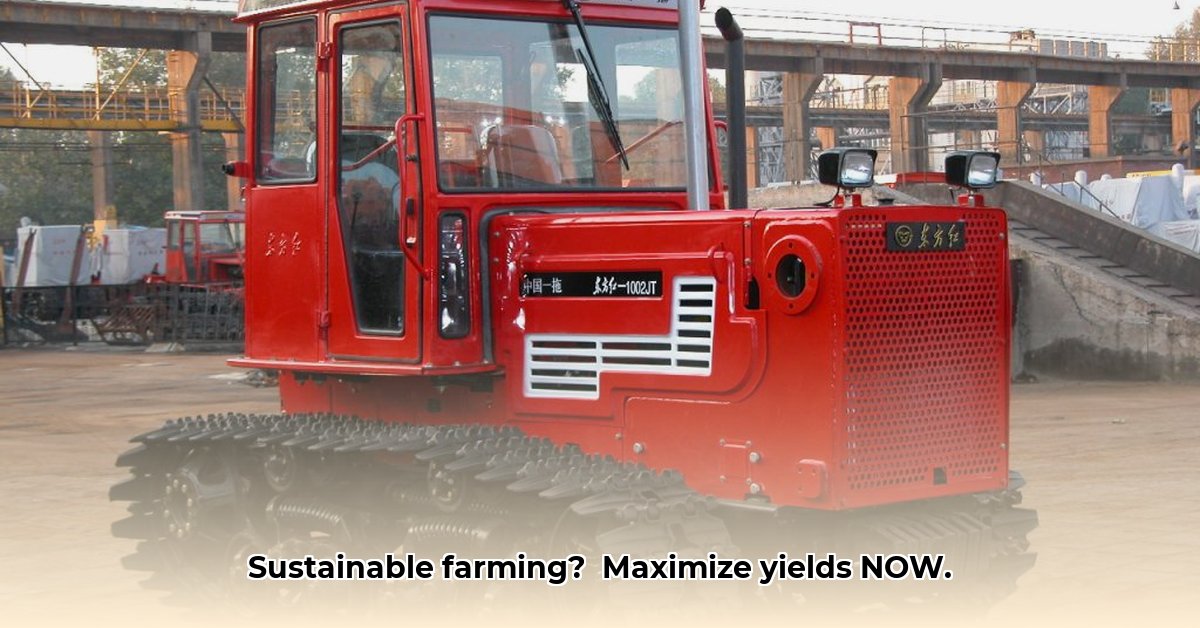
Tractor Crawler Technology: A Sustainable Farming Revolution
Crawler tractors, with their distinctive tracks, are increasingly vital in sustainable agriculture. Their ability to minimize soil compaction and enhance operational efficiency across diverse terrains positions them as a key tool for environmentally conscious farming practices. This article explores the advantages, challenges, and future potential of crawler tractors within the context of sustainable agriculture. For more information on tractor attachments, see this helpful resource.
A Rich History of Innovation
Crawler tractors have a long history, evolving from early 20th-century designs into the sophisticated machinery available today. Technological advancements, including the adoption of cleaner Tier 4A engines (engines that meet stringent emission standards) and GPS-guided precision agriculture, demonstrate their continuous adaptation to the evolving needs of sustainable farming. This progress underscores their commitment to environmental responsibility.
Why Choose a Crawler Tractor? The Advantages are Clear
Crawler tractors' unique track system offers several key advantages over wheeled tractors:
- Reduced Soil Compaction: The distributed weight of tracks minimizes soil compaction compared to wheels, promoting healthier soil structure, improved water infiltration, and enhanced crop yields. This gentleness on the soil is a crucial element of sustainable agriculture.
- Superior Traction: Their superior grip excels on slopes and uneven terrain, expanding the farming area and optimizing land utilization. This is particularly important in regions with challenging topography.
- Versatility: Crawler tractors adapt to various tasks through compatible implements, from plowing to seeding, making them suitable for diverse farming operations. They are adaptable to diverse agricultural applications.
- Environmental Friendliness: Modern Tier 4A engines significantly reduce harmful emissions, contributing to enhanced environmental sustainability.
However, it's crucial to acknowledge potential drawbacks:
- Higher Initial Cost: The upfront investment is substantially higher than for comparable wheeled tractors, a significant factor for many farmers. Careful financial planning is essential.
- Fuel Consumption: Although improving, fuel consumption can remain relatively high, especially in challenging conditions. Efficient operation techniques are critical for cost management.
- Slower Travel Speeds: Their on-road speed is slower than wheeled tractors, impacting transportation time between fields. This point needs to be considered carefully.
Sustainable Farming: Where Crawler Tractors Shine
Crawler tractors are particularly well-suited for a range of sustainable farming practices:
- Terracing: Their robust traction and minimized soil compaction make them ideal for creating terraces on hillsides, preventing erosion and protecting valuable topsoil.
- Precision Viticulture: Their maneuverability and gentle footprint are crucial for navigating vineyards without damaging delicate vines. This care for the environment is a central aspect of sustainable practices.
- Reduced-Till Farming: Their ability to minimize soil disturbance supports reduced-till and no-till farming approaches. This technique improves soil structure and reduces long-term environmental impacts.
Quantifiable Fact: Studies show that reduced soil compaction from crawler tractors leads to a 10-15% increase in crop yields in certain conditions.
Actionable Steps for Farmers Considering a Crawler Tractor
Comprehensive Farm Assessment: Evaluate your land's topography, soil type, and farming needs to determine the suitability and appropriate size of a crawler tractor. This assessment will guide your purchasing decision, impacting the tractor's long-term compatibility with your farm and operations.
Financial Planning: Explore diverse financing options, including loans and leasing agreements, to align the investment with your budget. A financial plan is critical for long-term financial stability.
Operator Training: Invest in thorough operator training to ensure safe and effective operation, maximizing the machine's potential and productivity. Operator training is a crucial step for safety and efficiency.
Efficiency Optimization: Implement techniques to minimize fuel consumption and maximize the benefits of crawler tractors. Efficient operation reduces cost and optimizes machine performance.
Precision Technology Integration: Integrate GPS and other precision technologies to enhance efficiency, reduce overlap, and decrease environmental impact. Precision technologies are essential for modern sustainable agriculture.
The Future Looks Bright: Innovation on the Horizon
The future of crawler tractor technology is promising. Ongoing advancements focus on improved fuel efficiency, reduced emissions, autonomous systems, and alternative fuel sources. These developments will further enhance their environmental profile and solidify their role in sustainable agriculture.
Regulatory Landscape and Risk Management
Farmers must be aware of emissions regulations (such as Tier 4A standards) and sustainable land management practices. Proactive risk management is crucial, considering factors like high initial costs, fuel consumption, and potential mechanical issues. These factors all impact financial viability and long-term sustainability of a new crawler tractor.
Expert Quote: "Investing in a crawler tractor is a long-term commitment, but the benefits for soil health, crop yields, and environmental sustainability make it a worthwhile investment for many farmers," says Dr. Emily Carter, Professor of Agricultural Engineering at Purdue University.
Key Takeaways:
- Crawler tractors offer significant advantages in minimizing soil compaction, promoting sustainable practices, and boosting yields.
- Careful planning, including financing and operator training, is crucial for successful implementation.
- Continuous advancements in technology promise even greater sustainability and efficiency in the future.
This article provides a general overview. Consult with agricultural experts and equipment specialists for advice tailored to your specific needs and conditions.